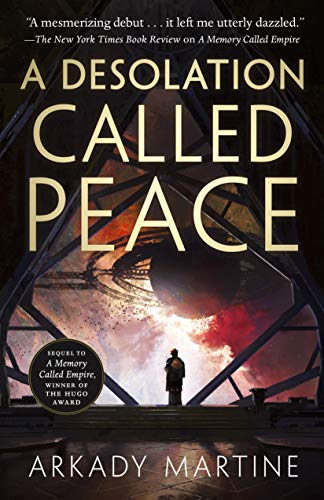With a cascade of luminous and psychologically intricate prose, Arkady Martine’s A Desolation Called Peace picks up shortly after the conclusion of A Memory Called Empire. It’s another brilliant book that I find even richer than the first volume of this series on the Teixcalaan Empire and its remote satellite, Lsel Station. The two novels should definitely be read in sequence.
A Teixcalaan fleet of warships has passed through the gate near Lsel to confront an alien fleet that is thus far ominously invisible and silent. The new emperor Nineteen Adze is taking charge in the capitol of the empire. And Mahit Dzamare has returned from her ambassadorship to Lsel where she faces a dangerous and uncertain future.
Right from the opening of A Desolation Called Peace, Martine contrasts different ideas of language, personhood, and how minds work. And she does this through several perspectives, unlike A Memory Called Empire which limited us to Mahit’s point of view. This story begins in the mind of the aliens and at once we get a rough idea that they regard humans or other “meat” creatures as something clumsy, strange and mostly useless.
The Prelude poses all sorts of questions that can’t be answered until much later in the story, but at least we are warned that there is a very different kind of intelligence and concept of language at work among the aliens. That strikes close to all that Teixcalaan civilization holds dear – its respect for unadulterated human minds and their elaborate language and forms of communication in which song and poetry are essential.
Soon we learn about Nine Hibiscus, the newly appointed commander or yaotlek of the fleet sent to confront the aliens. Much like Mahit in An Empire Called Memory, who struggled to fit into her new role of ambassador to Teixcalaan, Nine Hibiscus feels a bit awkward in her role, so different from that of a captain of a single ship. This is another recurring theme: the difficulty, sometimes generated by internal doubt, sometimes by external politics – or both – that the main characters experience in their new roles.
Eight Antidote is the eleven year-old heir to the throne, and adding his perspective is especially interesting. He is a kid, as everyone keeps reminding him, but he has to learn fast what it means to exercise power after he is made privy to critical conversations in the War Ministry. He becomes more and more adventurous as the story unfolds until he stumbles his way to a key role as the plot moves to its exciting climax.
Mahit herself is still struggling with the imago in her brain which overlays her own thinking, and sometimes physical actions, with those of her murdered predecessor Yskandr Aghavn. Now back on Lsel, she is no longer ambassador but still feels acutely the confusion of juggling awarenesses in her mind with the clear political threat of two factions. One simply wants her dead, and the other is considering if she could be useful as a spy before she is disposed of.
Three Seagrass, Mahit’s close friend and former guide in the Teixcalaan capital, is trying to fit into her new role in the Information Ministry and seizes on the first assignment that comes along. It is the dangerous one of flying to the front battlelines to help Nine Hibiscus figure out the meaning of a mysterious alien transmission. To accomplish that task she decides to fetch Mahit from Lsel and so saves her from what seems to be certain death.
After all these introductions, the story gets moving in earnest as Three Seagrass and Mahit arrive at the fleet’s flagship to help interpret the alien transmission. It moves with many surprises toward a powerful confrontation with the aliens while also dealing with each of the human conflicts in convincing and moving ways.
Martine revels in the intricacy of social and verbal interactions. Her characters, always under pressure, have to think through all the possible interpretations that could attach to their words, gestures and bearing. The style reminds me of Henry James or Edith Wharton, those early twentieth century writers whose characters were immersed in the complexities of a society where the wrong word or implication could ruin a reputation. Here it could destroy a life as well as a career.
For me this style has its payoff in the relationship between Mahit and Three Seagrass. It is the emotional core of the story, and each scene in which they try to communicate powerfully captures the push-pull of their feelings.
There is a remarkable moment between them when they first hear the alien recording. Like everyone who hears this hideous sound, they vomit in response to the overwhelming shrieks before getting to work trying to figure out if there are patterns that form the basis of communication. Then, after initial success in figuring out what the aliens are saying, when it’s time to clean up the mess they’ve made on the floor, they proceed to get entangled in every tense moment they have ever had together. Everything they say gets them deeper into misunderstanding as their inner anger and unexpressed love build. It’s completely believable and one of the best scenes I’ve read of frustrated communication.
Sometimes, especially in the earlier parts of the novel, Martine’s style of introspective probing of each character’s motivations becomes a drag on the action. Yes, it’s important to know how careful each word or action choice has to be, but there are moments when a page or two of reviewing all the possibilities is a bit much, especially when the words or actions taken are not all that surprising.
It’s a style that demands close reading, and the level of intellectualization of every interaction keeps emotion under tight rein. The payoff to this approach comes when a number of characters finally release their deepest feelings.
Aside from Mahit and Three Seagrass who struggle to figure out if what they feel for each other is love or something else, there is the vivid scene of Nine Hibiscus on the bridge of her ship, shouting through the tinny-sounding communication device linking her to a planet below, and desperately ordering her beloved second in command to return. As he ignores her and is seemingly on the verge of sacrificing himself to learn more about the aliens, she bellows terms of intimacy with her older companion, oblivious to everyone else in her presence.
The beauties of Martine’s style are many, and I found myself rereading several passages to savor the aptness of phrase, imagery and rhythm. Yet the language always serves dramatic purpose as key characters struggle through their fated roles. The ensemble of word, action, idea and character makes A Desolation Called Peace a book to be treasured.




Leave a Reply